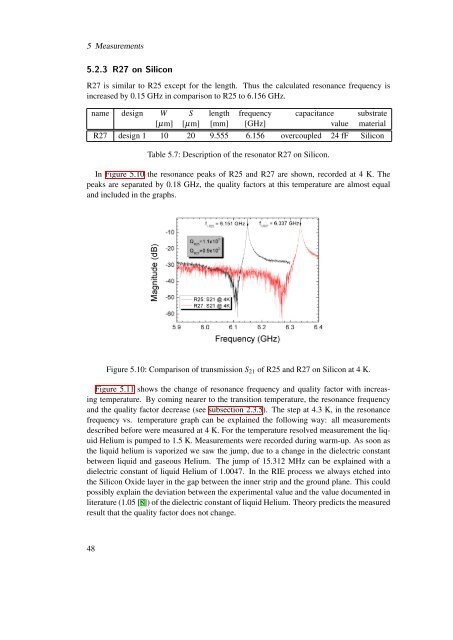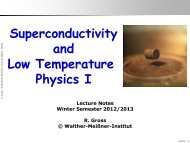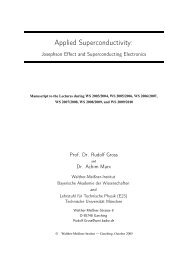Design, Fabrication and Characterization of a Microwave Resonator ...
Design, Fabrication and Characterization of a Microwave Resonator ...
Design, Fabrication and Characterization of a Microwave Resonator ...
Create successful ePaper yourself
Turn your PDF publications into a flip-book with our unique Google optimized e-Paper software.
5 Measurements5.2.3 R27 on SiliconR27 is similar to R25 except for the length. Thus the calculated resonance frequency isincreased by 0.15 GHz in comparison to R25 to 6.156 GHz.name design W S length frequency capacitance substrate[µm] [µm] [mm] [GHz] value materialR27 design 1 10 20 9.555 6.156 overcoupled 24 fF SiliconTable 5.7: Description <strong>of</strong> the resonator R27 on Silicon.In Figure 5.10 the resonance peaks <strong>of</strong> R25 <strong>and</strong> R27 are shown, recorded at 4 K. Thepeaks are separated by 0.18 GHz, the quality factors at this temperature are almost equal<strong>and</strong> included in the graphs.Figure 5.10: Comparison <strong>of</strong> transmission S 21 <strong>of</strong> R25 <strong>and</strong> R27 on Silicon at 4 K.Figure 5.11 shows the change <strong>of</strong> resonance frequency <strong>and</strong> quality factor with increasingtemperature. By coming nearer to the transition temperature, the resonance frequency<strong>and</strong> the quality factor decrease (see subsection 2.3.5). The step at 4.3 K, in the resonancefrequency vs. temperature graph can be explained the following way: all measurementsdescribed before were measured at 4 K. For the temperature resolved measurement the liquidHelium is pumped to 1.5 K. Measurements were recorded during warm-up. As soon asthe liquid helium is vaporized we saw the jump, due to a change in the dielectric constantbetween liquid <strong>and</strong> gaseous Helium. The jump <strong>of</strong> 15.312 MHz can be explained with adielectric constant <strong>of</strong> liquid Helium <strong>of</strong> 1.0047. In the RIE process we always etched intothe Silicon Oxide layer in the gap between the inner strip <strong>and</strong> the ground plane. This couldpossibly explain the deviation between the experimental value <strong>and</strong> the value documented inliterature (1.05 [8]) <strong>of</strong> the dielectric constant <strong>of</strong> liquid Helium. Theory predicts the measuredresult that the quality factor does not change.48
















